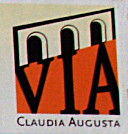Detailed directions about the route can be obtained from the altimetry (last figure of the gallery), from the captions of the individual photos and from the "Google Map" at the bottom right, which can be enlarged as desired. Double clicking on the photos you can view them at the highest resolution.
Description of the route

Via Claudia Augusta is easily traceable on maps along the first section between Altino and Olmi di Treviso: a long straight road, as was the norm with Roman roads that cut through low-lying flat lands. Today only a part of this straight alignment is still used as a road. This short route starting at Treviso is in search of the remains of the ancient road as far as Quarto d’Altino.
Point of departure is the train station at Treviso, on the Venezia-Udine line. Upon leaving the station we head to the center of the city, Piazza dei Signori, behind which is the attractive Piazzetta [small piazza] di San Vito; continue to the north city wall, leaving the historic center by way of the San Tommaso gate; and cross the roadway that runs around the city walls and joining up with the bike lane on the right side of Viale [avenue] Vittorio Veneto right in front of the gate.
We travel along this viale until we get to Via Brigata Marche on the right which is also provided with a bike lane, alternately on the right and the left sides of the road. The road runs as a straight shot heading east as far as the large Villa Tiepolo Passi in the locality of Carbonera.
After the villa we continue along the bike route traveling around the villa, then off to the right on a local road (Via Roma) until we rejoin the main road, pass under a highway and soon after turn right onto Via Quintavalle; one then finds on the right Via Valdemoneghe which now is on the straight alignment of Claudia Augusta; the road however is interrupted by the railroad tracks so that we need turn left and follow along the tracks for a short section as far as the train station at Olmi, where there is an overpass which allows us to cross to the other side, turning again to the right and shortly after coming back to the alignment of Claudia Augusta, which here has become a short residential street, Via Venezia, at the end of which we come to a large rotary on the right, at the far side of which is Via Agozzo(*) which continues more or less on the alignment of the ancient Via Claudia Augusta.
We go through a series of rotaries until finally we cross Via Treviso-Mare; shortly after, on the left, we find a small street with a strange name Via Malviste [street of riffraff] which quickly returns us to the alignment of the ancient Roman road; and at this point the name Via Claudia Augusta actually appears on the street signs; from here on the ancient name has been retained.
After a while it is possible to take a detour to the left to Roncade where you can visit the Castello di Roncade [Roncade castle], known also as Villa Giustinian. Then, from here it is possible to rejoin Claudia Augusta further to the south.
The remaining section is a long straight unpaved section which takes one to Musestre and the river Sile, but with some difficulties along the final stretch which is unpaved and increasingly broken up; towards the end of the rainy season one can find the road turned into a bog and the remaining travel most difficult. Once at Musestre one reaches the bridge over the Sile across which is Quarto d’Altino, with a train station on the Venezia-Trieste line.
The remaining section of Via Claudia Augusta takes one to the museum and ruins of Altino and is described on a different page.
According to some sources, a local derivation of Augusta. RB
X